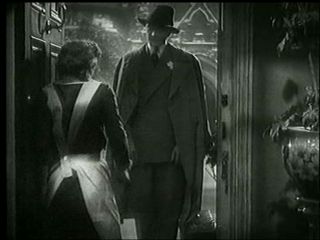The MacGuffin: News and Comment (27/Oct/2012)
(c) Ken Mogg (2012)
October 27
I keep referring here to G.K. Chesterton's tale 'Manalive' (1912), the first such reference being perhaps that on August 25, above, where I bring it into a discussion of Absurdity (including Hitchcockian Absurdity). I believe that it had a big influence on Hitchcock's 'vitalist' imagination, and it even contains the 'missing link' I had long sought where Chesterton acknowledges that his extravagant tales are aimed squarely at the reader, to make him/her think positively. (Chesterton's Father Brown may be the author's most popular representative in that respect.) In one key passage, the tale's 'saviour' figure, Innocent Smith, teaches the importance of living life to a stuffy academic, whose two 'bad habits' are described as having been 'to sit up all night and to be a student of Schopenhauer'. (Yes, in 1912 Schopenhauer's influence on British intellectuals was still considerable. Cf the Schopenhauer-like philosopher, Professor Huvelius, who may be behind the German invasion - and the attacks by birds and other wild creatures - in Arthur Machen's 'The Terror', published in 1917. Further reading). Chesterton's tale opens and closes in a London boarding house whose residents are transformed by Smith's sojourn among them. But the actual broad narrative has at least one antecedent. English humorist Jerome K. Jerome ('Three Men in a Boat') had first written a short allegorical tale of his own and then adapted it to the London stage, where it played as 'The Passing of the Third Floor Back' in 1908 - and later was adapted into two film versions, the second in 1935 when it was directed by Berthold Viertel from a script by Alma Reville (Mrs Alfred Hitchcock) and Michael Logan (who went on to write the adaptation for Hitchcock's Rebecca). It starred Conrad Veidt (so another German connection) as The Stranger who comes to live among the inhabitants of a London boarding house. And his arrival prompts this very clear visual homage to Hitchcock's The Lodger (1926): see frame-capture below. Note the church over the road, hinting at the character's 'religious purpose' in what follows. Now, not only did I watch The Passing of the Third Floor Back (again) recently but I was prompted by memories of Pasolini's Teorema (1968) to order the latter in a nice BFI DVD copy. Sure enough, it, too, though set in a household in Milan, has structural affinities with the Jerome and Chesterton and Viertel works. Pasolini, I read, has said that The Visitor (played by Terence Stamp) in his film 'isn't Christ but either God or the Devil', leaving it to the viewer to decide. Which I find very Hitchcockian of Pasolini! Indeed, I see more clearly now how Hitchcock's Shadow of a Doubt (1943) also fits the mold. How masterful of its director to make Uncle Charlie (Joseph Cotten) a clear Devil-figure but also, if you care to take up Pasolini's hint, a possible emissary of God (despite Uncle Charlie's crimes) sent to bring 'life' back to the incipiently moribund Newton household that we first see! I recall that at one point, as Uncle Charlie lies on a bed, the bedhead appears to give him angel-like wings - much as one image of Stamp in Teorema appears to give him such wings, too. All very teasing! Or, as they say in Under Capricorn (1949), 'The Lord moves in mysterious ways/ His wonders to perform.' Of course, Hitchcock might have explained that he merely wanted to keep his film as multi-valent and life-like and non-dogmatic in as many, non-mutually-exclusive ways as possible, taking advantage of the built-in 'ambiguous image' (as Roy Armes called it) that cinema offers, and another facet of 'pure cinema' (so akin to Schopenhauer's amorphous cosmic Will), after all. It would be easy to extend this reading to other Hitchcock films such as Psycho (Norman Bates as the audience's saviour) and The Birds (where the saviour-figure is the birds themselves - something that a writer in the UK journal 'Movie' once noted, 'a whole Christ population of birds!'). I further discussed this matter recently with Hitchcock-authority TL. We agreed that it helps to understand Hitchcock's genius if you think of him drawing on 'scraps' of remembered storylines - a bit of Chesterton here, a bit of Thornton Wilder there - and as having, in TL's words, 'a magpie eye for sharp individual motifs, moments, and scenes', thus revealing how he assembled his films in a bottom-up (non-theoretical) way rather than an imposed top-down way. Nonethless, I ventured, the result is not a meaningless 'nothing' (which someone like Penelope Houston thought she detected and chose to deride in her essay "The Figure in the Carpet") but a reality at least analogous to Schopenhauer's Will, 'which has its complement, Representation, and that when you realise that the two go together, and can't be separated, brings you to a very special understanding of the experience that a Hitchcock film offers.' Especially one like, say, Vertigo, I added.
This material is copyright of Ken Mogg and the Hitchcock Scholars/'MacGuffin' website (home page) and is archived with the permission of the copyright holder. |

